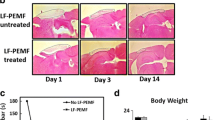Abstract
Cerebrovascular accidents (CVAs), commonly known as strokes, can damage the brain through vascular injuries caused by either blood vessel blockages (ischemic stroke) or ruptures (hemorrhagic stroke) which disrupt regular brain blood supply and can cause severe damage to the individual. The objective of the present study was to evaluate the effects of photobiomodulation with a light-emitting diode (LED) device (904 nm, 110 mW, 7 J/cm2) on neurogenesis, muscle resistance, and motor behavior in animals submitted to an experimental model of hemiplegia. The sample consisted of 30 Wistar rats, divided into two groups: control group (GC) and 904-nm LED-treated group (TG). All animals underwent stereotactic surgery for electrode implant and subsequent electrolytic injury to induce an ischemic stroke. TG was subjected to daily LED irradiation (904 nm, 110 mW, 7 J/cm2) for 63 s. Suspension test results indicate an improvement of TG muscle resistance when compared with baseline evaluation (BLT); a reduction in open-field freezing time and the number of fecal bolus pellets suggest diminished anxiety induced by 904-nm LED treatment on treatment days 7 and 21 (TG7 and TG21) compared with the baseline results; and lastly, histological analysis showed important signs of neurogenesis in TG in comparison to CG, especially on treatment days 7 and 21 (TG7 and TG21). In conclusion, the present study suggests that 904-nm LED irradiation may beneficially affect neurogenesis, muscle resistance, and animal motor behavior following ischemic CVA.




Similar content being viewed by others
References
Thrift AG, Cadilhac DA, Thayabaranathan T, Howard G, Howard VJ, Rothwell PM, Donnan GA (2014) Global stroke statistics. Int J Stroke 9:6–18
Yang L, Tucker D, Dong Y, Wu C, Lu Y, Li Y, Zhang Q (2018) Photobiomodulation therapy promotes neurogenesis by improving post-stroke local microenvironment and stimulating neuroprogenitor cells. Exp Neurol 299:86–96
Andrabi SS, Parvez S, Tabassum H (2017) Progesterone induces neuroprotection following reperfusion-promoted mitochondrial dysfunction after focal cerebral ischemia in rats. Dis Model Mech 10:787–796
Lee HI, Lee SW, Kim NG, Parque KJ, Choi BT, Shin YI, Shin HK (2017) Low-level light emitting diode (LED) therapy suppresses inflammasome-mediated brain damage in experimental ischemic stroke. J Biophotonics 10:1502–1513
Morries LD, Cassano P, Henderson TA (2015) Treatments for traumatic brain injury with emphasis on transdermal infrared laser phototherapy. Neuropsychiatr 11:2159–2175
Lee HI, Lee SW, Kim NG, Park KJ, Choi BT, Shin YI, Shin HK (2017) Low-level light emitting diode therapy promotes long-term functional recovery after experimental stroke in mice. J Biophotonics 10(12):1761–1771
Yang Y, Zhao Q, Zhang Y, Wu Q, Jiang X, Cheng G (2018) Effect of mirror therapy on recovery of stroke survivors: a systematic review and network meta-analysis. Neuroscience 390:318–336
Henderson TA (2016) Multi-watt near-infrared light therapy as a neuroregenerative treatment for traumatic brain injury. Neural Regen Res 11(4):563
Wang Q, Yang L, Wang Y (2015) Enhanced differentiation of neural stem cells to neurons and promotion of neurite outgrowth by oxygen–glucose deprivation. Int J Dev Neurosci 43:50–57
Baptista P, Andrade JP (2018) Adult hippocampal neurogenesis: regulation and possible functional and clinical correlates. Front Neuroanat 12:44
Shohayeb B, Diab M, Ahmed M, Ng DCH (2018) Factors that influence adult neurogenesis as potential therapy. Transl Neurodegener 7(1):4
Pazaiti A, Soubasi V, Spandou E, Karkavelas G, Georgiou T, Karakis P, Guiba-Tziampiri O (2009) Evaluation of long-lasting sensorimotor consequences following neonatal hypoxic-ischemic brain injury in rats: The neuroprotective role of MgSO4. Neonatology 95:33–40
Sestakova N, Puzserova A, Kluknavsky M, Bernatova I (2013) Determination of motor activity and anxiety-related behavior in rodents: methodological aspects and role of nitric oxide. Interdiscip Toxicol 6(3):126–135
Miri AL, Hosni AP, Gomes JC, Kerppers II, Da Silva Pereira MC (2017) L-tryptophan study on depression in Alzheimer’s disease in experimental models. J Phys Educ 28(1):2839
Paxinos GC (1986) Watson The rat brain in stereotaxic coordinates. Academic, New York, p 8
Kerppers II, Lima CJ, Fernandes AB, Villaverde AB (2015) Effect of light-emitting diode (ʎ 627 nm and 945 nm ʎ) treatment on first intention healing: Immunohistochemical analysis. Lasers Med Sci 30(1):397–401
Naeser M, Ho M, Martin P, Treglia E, Krengel M, Hamblin M, Baker E (2012) Improved language after scalp application of red/near-infrared light-emitting diodes: pilot study supporting a new, noninvasive treatment for chronic aphasia. Procedia Soc Behav Sci 61:138–139
Henderson TA, Morries LD (2015) Near-infrared photonic energy penetration: can infrared phototherapy effectively reach the human brain? Neuropsychiatr Dis Treat 11:2191
Hamblin MR (2016) Shining light on the head: photobiomodulation for brain disorders. BBA Clin 6:113–124
Vahid-Ansari F, Lagace DC, Albert PR (2016) Persistent post-stroke depression in mice following unilateral medial prefrontal cortical stroke. Transl Psychiatry 6(8):863
Thunshelle C, Hamblin MR (2016) Transcranial low-level laser (light) therapy for brain injury. Photomed Laser Surg 34(12):587–598
Lee HI, Park JH, Park MY, Kim NG, Parque KJ, Choi BT, Shin HK (2016) Pre-conditioning with transcranial low-level light therapy reduces neuroinflammation and protects blood-brain barrier after focal cerebral ischemia in mice. Restor Neurol Neurosci 34(2):201–214
Author information
Authors and Affiliations
Corresponding author
Ethics declarations
All experiments were carried out in accordance with the Ethics Committee on the Use of Animals (CEUA) of the Central Western State University (UNICENTRO)—research protocol number 034/2017.
Conflict of interest
The authors declare that there is no conflict of interest.
Additional information
Publisher’s note
Springer Nature remains neutral with regard to jurisdictional claims in published maps and institutional affiliations.
Rights and permissions
About this article
Cite this article
de Jesus Fonseca, E.G., Pedroso, A., Neuls, D. et al. Study of transcranial therapy 904 nm in experimental model of stroke. Lasers Med Sci 34, 1619–1625 (2019). https://doi.org/10.1007/s10103-019-02758-9
Received:
Accepted:
Published:
Issue Date:
DOI: https://doi.org/10.1007/s10103-019-02758-9




